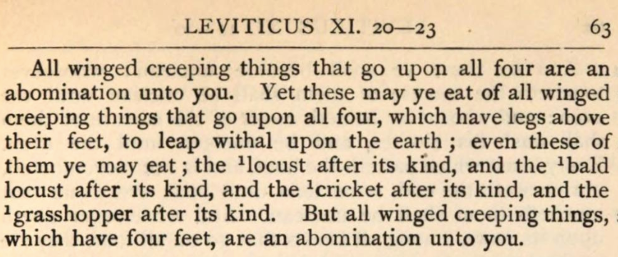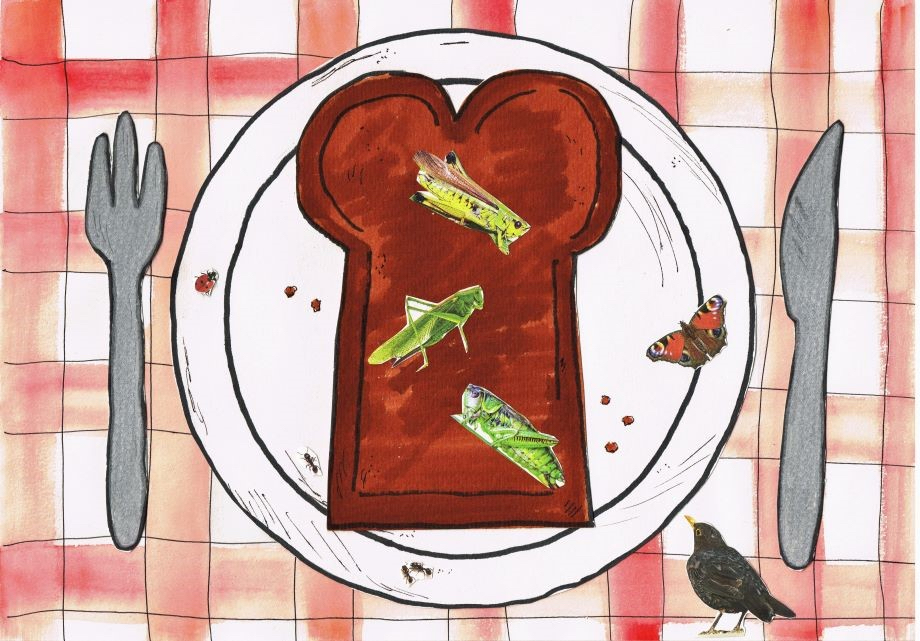Why You (Wrongly) Think That Eating Bugs is Gross
Caterpillar popcorn, ant-egg caviar, mealworm pasta; just to name a few products that, in the future, might grace our daily menus. Why? Because in this changing world, we need to change our diet. The problem is, we, the ‘Western society’, remain somewhat hesitant to embrace this culinary revolution, even as insect products are enjoyed in other parts of the world. Where does this mental stigma come from?
The complexity of eating
We humans are omnivores, which means we can eat a wide array of foods. However, this does mean we are faced with a perpetual conflict, called ‘the omnivores dilemma’.1 On the one hand, we are very curious, driven by a desire to escape culinary monotony and try new foods. On the other hand, there’s an instinctive aversion to the unfamiliar due to the possible toxicity and danger of unknown food. This instinctual wariness towards novel foods is a product of our evolutionary history — a ‘learned safety’ mechanism aimed at preventing negative sensory experiences, illness, or worse.2 This dislike sometimes takes the form of disgust, particularly in case of insects. In Western culture, the ‘disgust factor’ stands out as the most prominent barrier when it comes to the consumption of insects.3 However, the story of insect aversion goes beyond mere unfamiliarity with the food item.
Understanding the origin of the Western aversion to insects as food is not a straightforward task. There is no simple answer, nor any scientific consensus, as food habits are inherently complex. According to philosopher Annemarie Mol, the process of what to eat, when to eat, and how to eat is a ‘stretched-out, historically dispersed, socio-material collective’.4 What she means is that these decisions are not solely dependent on personal preferences but are deeply intertwined with history, ecology, culture, nutrition, senses, society, enjoyment, and economy. Our perceptions and attitudes towards food are revealed through eating habits and meanings given to food items, which shows that eating constitutes to our way of life and a sense of belonging. So, let us unravel some facets that might have shaped the Western insect perspective of today.
Insects in the diet of our ancestors
Delving into history, we find that insects were once a part of our diets, enjoyed as juicy snacks by our hunter-gatherer ancestors.5 They would provide us with good fats, fibers, vitamins, and, of course, proteins. The tide turned during the agricultural revolution, with Eurasian societies domesticating large mammals.6 These animals were more than just food; they gave strength, clothing, and companionship, making insects a less profitable food source. Slowly, insects were excluded from our diets. In other parts of the world, where large mammals were scarce or were less suitable for domestication, people relied more on small game such as insects. For example, the complex and dense society of the Aztecs in Mesoamerica relied heavily on the proteins from insects. They were even known to semi-cultivate insect eggs in marshes and ponds.7 In general, societies in tropical areas were more likely to keep insects in their diet, primarily because tropical insects are often larger, more abundant, and available year-round.8
Even though insects were not domesticated for food in Western countries, their consumption was not totally absent from Western history.9 The Bible contains references to the consumption of locusts in both the Old and New Testaments (figure 1). Even Aristotle, the ancient Greek philosopher, mentioned eating cicada nymphs and adults in his writings.10

Figure 1: Dietary laws outlined in the Old Testament (Leviticus 11:22) regarding permissible
and forbidden foods, four kinds of locust are described to be permitted.
Nevertheless, insects remained among the least esteemed life forms throughout the history of the Western world. Aristotle, in his ‘Scala Naturae,’ placed insects in the lowest order of life. In times of famine, insects were categorized as ‘non-food’ items, consumed only in times of extreme desperation when normal social structures had crumbled.10 In the ages that passed, insects were encountered as pests for crops, as maggots in waste, or as lice in hair. These negative encounters probably contributed to a widespread belief that insects were carriers of diseases and even manifestations of the devil himself.11 The consumption of such creatures would only align with apocalyptic visions of the end of the world. So, insects did not secure a substantial place in the diets of Western farmers and urban dwellers.
The barbarisation of eating insects
When Europeans embarked on voyages across the globe during the 15th century, they came in contact with cultures that did love to eat insect.8 Some descriptions of these encounters are neutral or even positive: a settler living in South Australia wrote that the witchetty grub (moth caterpillar), when lightly fried, was a ‘delicacy fit for the most educated palate’.12 However, the abundancy of records depicted disgust. Chronicler López de Gómara, situated in South America in the 16th century, scorned the native’s diet: ‘There is not a single thing that they will not guzzle, and it is all the more astonishing that they eat such dirty animals and bugs given that they now have good bread and wine, fruits, fish and meat’.13
Being a wheat-eating overseer thus inherently distinguished you from the insect-eating natives. This constant colonial desire to differentiate from indigenous cultures by rejecting their food can be understood through the ‘distinction theory’ proposed by sociologist Bourdieu. According to this theory, taste preferences extend beyond individual choices to serve as a means of expressing cultural and social hierarchy. As Bourdieu said: ‘taste classifies and classifies the classifier’.14 Therefore, the disgust expressed by De Gómara and many other Europeans towards insect consumption goes beyond a simple distaste; it embodies a deeper moral connotation used to justify segregation. For the Europeans, the ‘barbaric inability’ to distinguish un-food with real food was evidence that indigenous people were underserving of freedom and relied on European guidance. This, in turn, led to colonial policies actively banning insect-eating practices, altering traditional dietary habits.13 Today’s Western misconception of insects as a barbaric food item can be partly traced back to this complex history shaped by colonialism. Thus, while colonialism has been officially abolished, its lingering effects on food culture continues to be discernible.
Why we need to change
The predicament we face today is clear. Currently, to produce all the food we eat (and throw away) we use up a ton of resources, with the meat industry alone contributing to 15% of all anthropogenic greenhouse gases.15 At the same time, agriculture and food production are suffering the consequences of the changing climate. Already now, climate change leads to more extreme weather patterns, causing crops to fail and land to be inhabitable. This leads to an escalating difficulty in feeding the global population, especially when malnutrition and food scarcity already affect many people.15 That is why, to preserve a habitable planet for both humanity and other species, innovative transformations of the existing food system and diets are needed. And that is where insects come in, being part of one of the potential healthy and sustainable protein alternatives.7
The journey towards embracing insects as a part of our diet is indeed a complex one, as the origin of the aversion is laid in a ‘psychobiological, historically dispersed, socio-material collective’. Food norms and values function, to the basis, as a safety net for our omnivorous diet. Therefore, in the West, insects trigger the disgust response as they are an unfamiliar and alienated food item. However, these norms and values are, in turn, expressions of one’s identity and highly dependent on social structures and power. Acknowledging the historical context that has shaped this Western aversion to insects is crucial. Especially given the continued influence of so-called ‘Western’ diets and habits worldwide, fuelled by globalisation.16 Globalisation contributes to the adoption of a homogenised cultural system leading to the erosion of traditional values and practices in some societies.17 This homogenised cultural system is highly influenced by Western customs and habits, leading to the current (often maladaptive) nutritional transition to a ‘Western’ diet. This includes the rejection of insects as food. Given the numerous benefits of incorporating insects into a diet, especially for a growing world population, addressing this global decline or transformation in insect consumption becomes imperative. One potential solution lies in promoting the acceptance and desirability of insects as normal food in Western society.
As we begin to realise the advantages of insect consumption in the West, let us not merely follow curiosity, but also savour the delight these intriguing food items offer. All complexity aside, it is deliciousness that will bring us back for more. To learn, we must turn to cultures where insects have always been on the menu.18 Instead of scorning their practices like the colonizers have done, we should embrace their knowledge, and find inspiration in their recipes. Take for example ‘nsenene’, a Ugandan treat for popcorn-like grasshoppers. Or ‘Mexican caviar’, small water bug eggs which was already a delicacy of the ancient Aztects. Together, we can make a sustainable change in what we eat, one delicious insect at a time.
1. Pliner, P., & Salvy, S. (2006). Food neophobia in humans. Frontiers in nutritional science, 3, 75.
2. Curtis, V. A. (2014). Infection-avoidance behaviour in humans and other animals. Trends in Immunology, 35(10), 457-464.
3. Dagevos, H. (2021). A literature review of consumer research on edible insects: recent evidence and new vistas from 2019 studies. Journal of Insects as Food and Feed, 7(3), 249-259.
4. Mol, A. (2021). Eating in theory. Duke University Press.
5. McGrew, W. C. (2014). The ‘other faunivory’revisited: Insectivory in human and non-human primates and the evolution of human diet. Journal of human evolution, 71, 4-11.
6. Diamond, J. M. (1998). Guns, germs and steel: a short history of everybody for the last 13,000 years. Random House.
7. Parsons, J. R. (2010). The pastoral niche in pre-Hispanic Mesoamerica. Pre-Columbian foodways: interdisciplinary approaches to food, culture, and markets in ancient Mesoamerica, 109-136.
8. Dossey, A. T., Morales-Ramos, J. A., & Rojas, M. G. (Eds.). (2016). Insects as sustainable food ingredients: production, processing and food applications. Academic Press.
9. Van Huis, A., Van Itterbeeck, J., Klunder, H., Mertens, E., Halloran, A., Muir, G., & Vantomme, P. (2013). Edible insects: future prospects for food and feed security (No. 171). Food and agriculture organization of the United Nations.
10. Brothwell, D., & Brothwell, P. (1969). Food in antiquity: a survey of the diet of early peoples. Frederik A.
11. Fukano, Y., & Soga, M. (2021). Why do so many modern people hate insects? The urbanization–disgust hypothesis. Science of the Total Environment, 777, 146229.
12. Singley, B. (2012). ‘Hardly anything fit for man to eat’: food and colonialism in Australia. History Australia, 9(3), 27-42.
13. Earle, R. (2012). The body of the conquistador: Food, race and the colonial experience in Spanish America, 1492–1700. Cambridge University Press. p. 119.
14. Bourdieu, P. (1987). Distinction: A social critique of the judgement of taste. Harvard university press.
15. Godfray, H. C. J., Aveyard, P., Garnett, T., Hall, J. W., Key, T. J., Lorimer, J., … & Jebb, S. A. (2018). Meat consumption, health, and the environment. Science, 361(6399), eaam5324.
16. DeFoliart, G. R. (1999). Insects as food: why the western attitude is important. Annual review of entomology, 44(1), 21-50.
17. Popkin, B. M., Adair, L. S., & Ng, S. W. (2012). Global nutrition transition and the pandemic of obesity in developing countries. Nutrition reviews, 70(1), 3-21.
18. Deroy, O., Reade, B., & Spence, C. (2015). The insectivore’s dilemma, and how to take the West out of it. Food Quality and Preference, 44, 44-55.

Eva Speijer is a master student Ecology and Evolution at the UvA. Besides her overall love for nature and science, she is especially intrigued by explaining human behaviour and societal processes from an evolutionary perspective. Other than that, she enjoys cooking, painting, and camping.

